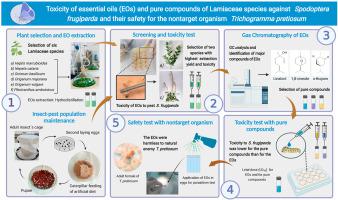Crop Protection ( IF 2.5 ) Pub Date : 2022-04-30 , DOI: 10.1016/j.cropro.2022.106011 Camila Silva Bibiano 1 , Dejane Santos Alves 2 , Brenda Caroline Freire 3 , Suzan Kelly Vilela Bertolucci 1 , Geraldo Andrade Carvalho 3

|
The fall armyworm (FAW) Spodoptera frugiperda is a key pest of countless cultures of economic importance. FAW control is still mostly achieved by using synthetic chemicals and genetically modified plants, which can cause adverse effects on nontarget organisms. In this sense, secondary metabolites are an inexhaustible source of bioactive substances. Thus, this study investigated the insecticidal activity of essential oils (EOs) of plants of the Lamiaceae family against FAW. The EOs from Hyptis marrubioides (LD50 = 18.49 μg/larvae) and Ocimum basilicum (LD50 = 38.21 μg/larvae) were toxic to FAW in topical bioassays. The majority of compounds of H. marrubioides were identified as β-thujone (41.50%) and α-thujone (15.82%), while for O. basilicum, linalool (35.68%) and 1,8-cineole (16.03%) were the major substances. The pure compounds linalool (survival probability = 28.1%), α-thujone (survival probability = 24.5%) and 1,8-cineole (survival probability = 40.4%) were employed in a new bioassay; although all substances were toxic to FAW, the toxicity was less than that observed for EOs from H. marrubioides (survival probability = 9.5%) and O. basilicum (survival probability = 2.1%). These results suggest that there is more than one active substance in the EOs or else, there is synergism and/or an additive effect between the substances. With regard to the experiment conducted with the parasitoid Trichogramma pretiosum, the EOs from H. marrubioides and O. basilicum were classified as harmless according to the IOBC criteria, so they are safe for this parasitoid and have potential to be used in programs of integrated FAW pest management the natural enemy T. pretiosum.
中文翻译:

唇形科植物精油和纯化合物对草地贪夜蛾(鳞翅目:夜蛾科)的毒性及其对非目标生物体赤眼蜂(膜翅目:赤眼蜂科)的安全性
秋粘虫 (FAW) Spodoptera frugiperda是无数具有经济重要性的文化的主要害虫。FAW 的控制仍然主要通过使用合成化学品和转基因植物来实现,这会对非目标生物造成不利影响。从这个意义上说,次级代谢物是取之不尽的生物活性物质来源。因此,本研究调查了唇形科植物精油 (EOs) 对 FAW 的杀虫活性。来自Hyptis marrubioides (LD 50 = 18.49 μg/幼虫) 和罗勒(LD 50 = 38.21 μg/幼虫) 的EO 在局部生物测定中对 FAW 有毒。大多数化合物H. marrubioides被鉴定为 β-thujone (41.50%) 和 α-thujone (15.82%),而O. basilicum的主要物质是芳樟醇 (35.68%) 和 1,8-桉树脑 (16.03%)。纯化合物芳樟醇(存活概率 = 28.1%)、α-thujone(存活概率 = 24.5%)和 1,8-桉树脑(存活概率 = 40.4%)用于新的生物测定;尽管所有物质都对 FAW 有毒,但毒性低于观察到的来自H. marrubioides(存活概率 = 9.5%)和O. basilicum的 EO(生存概率 = 2.1%)。这些结果表明在 EO 中存在不止一种活性物质,否则物质之间存在协同作用和/或相加效应。以寄生蜂Trichogramma pretiosum进行的实验,根据IOBC 标准, H. marrubioides和O. basilicum的 EO 被归类为无害,因此它们对这种寄生蜂是安全的,并有可能用于综合 FAW 计划害虫管理天敌T. pretiosum。











































 京公网安备 11010802027423号
京公网安备 11010802027423号